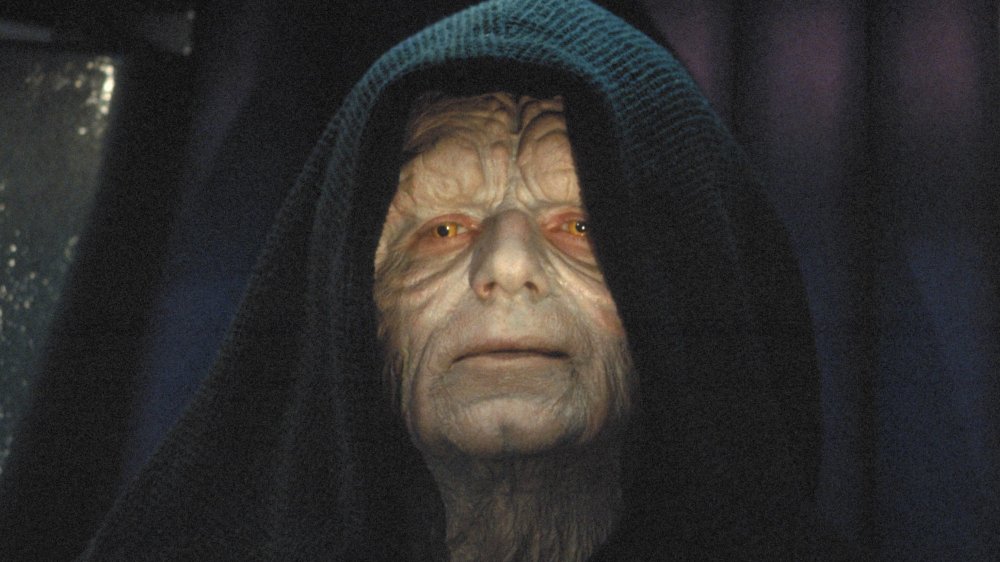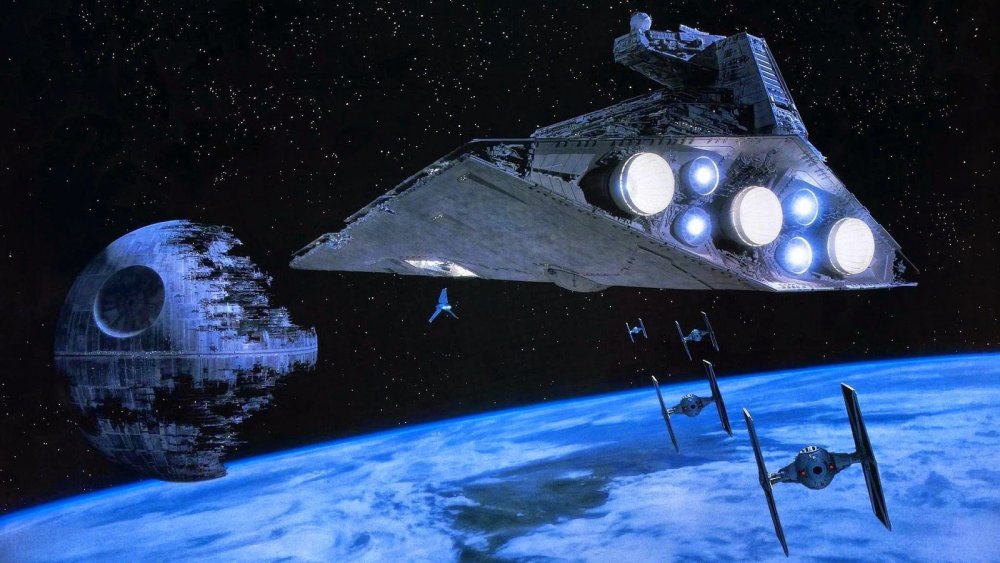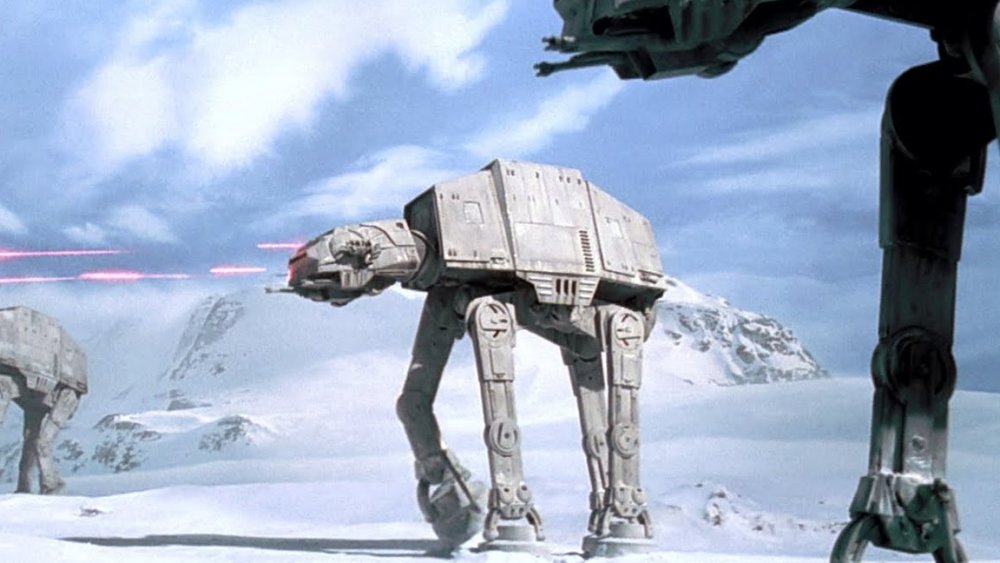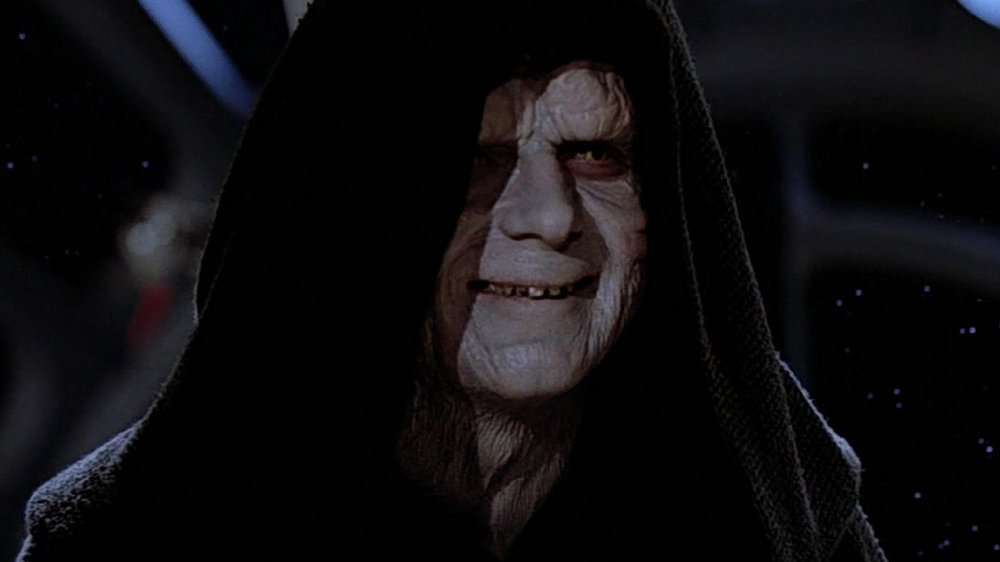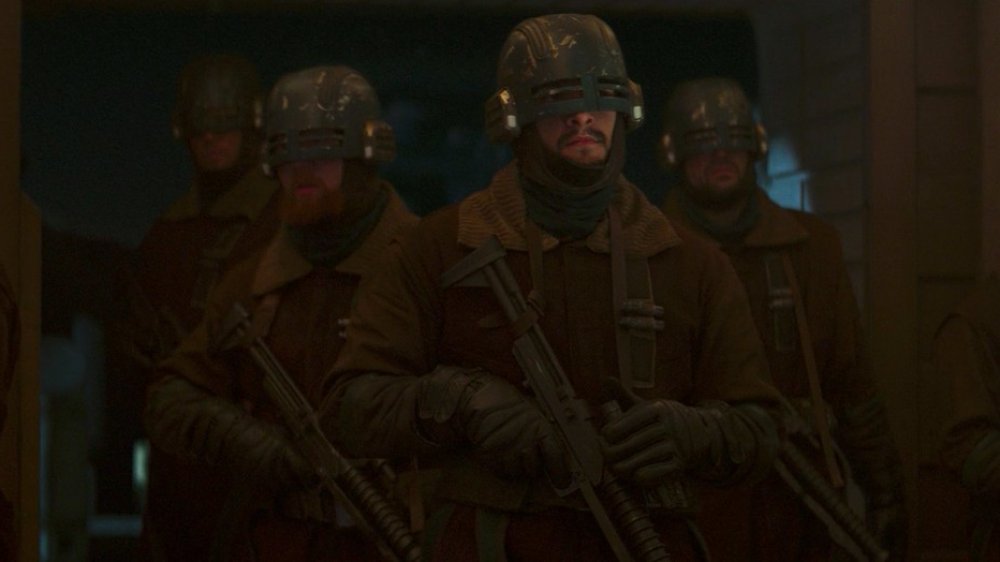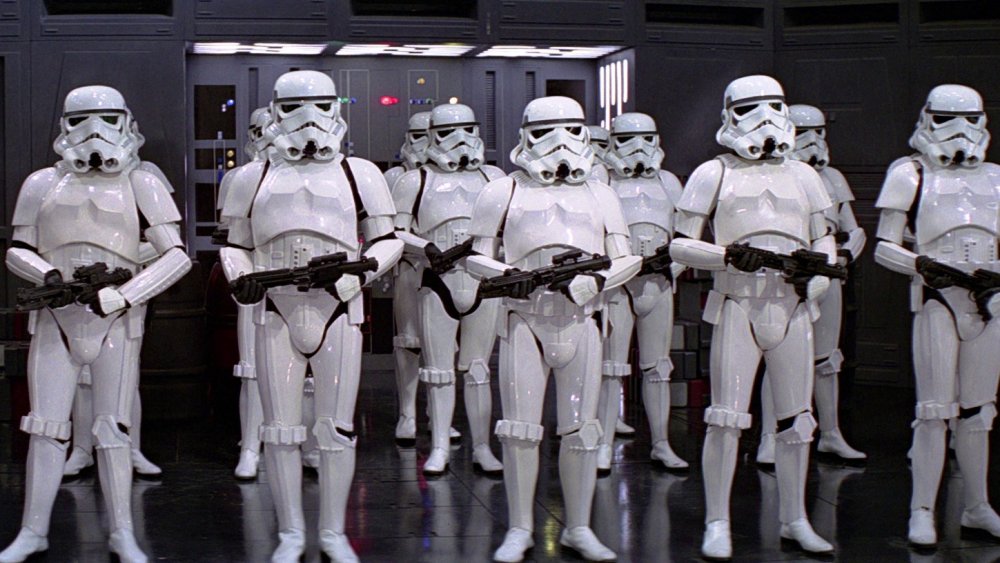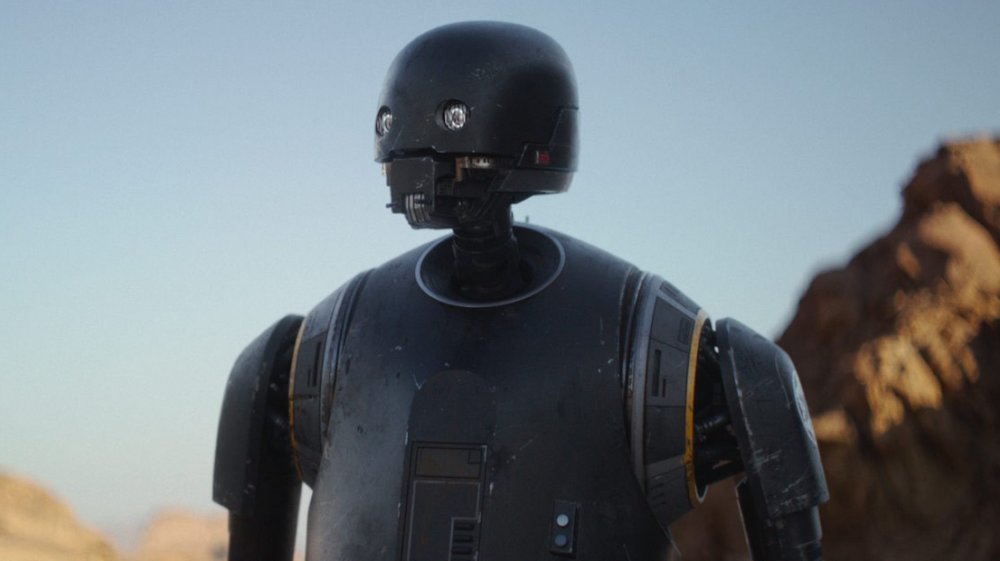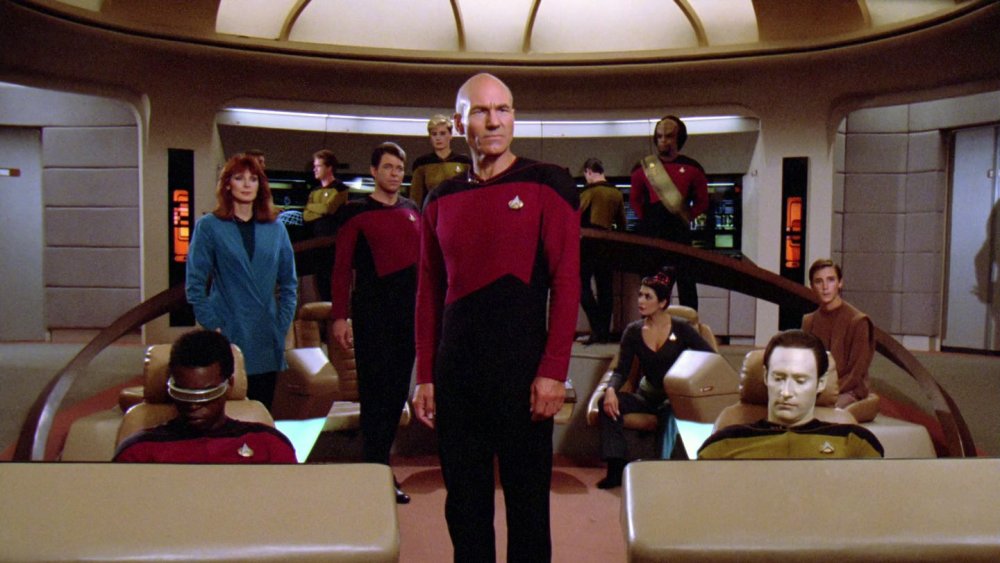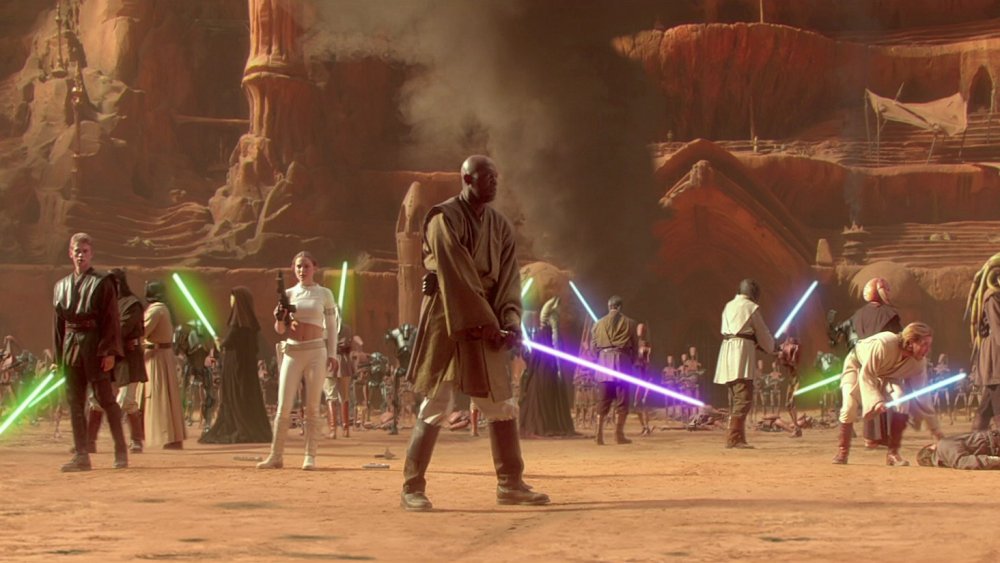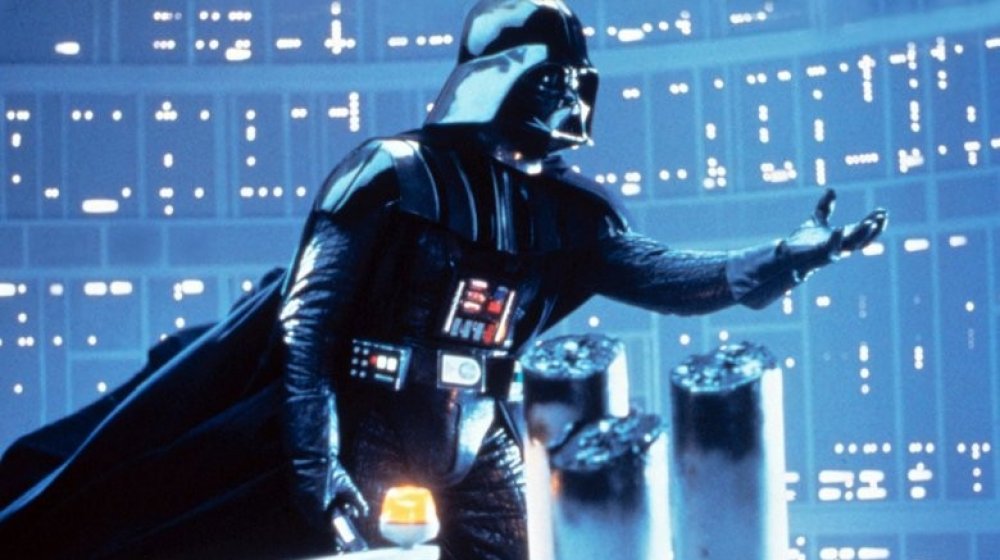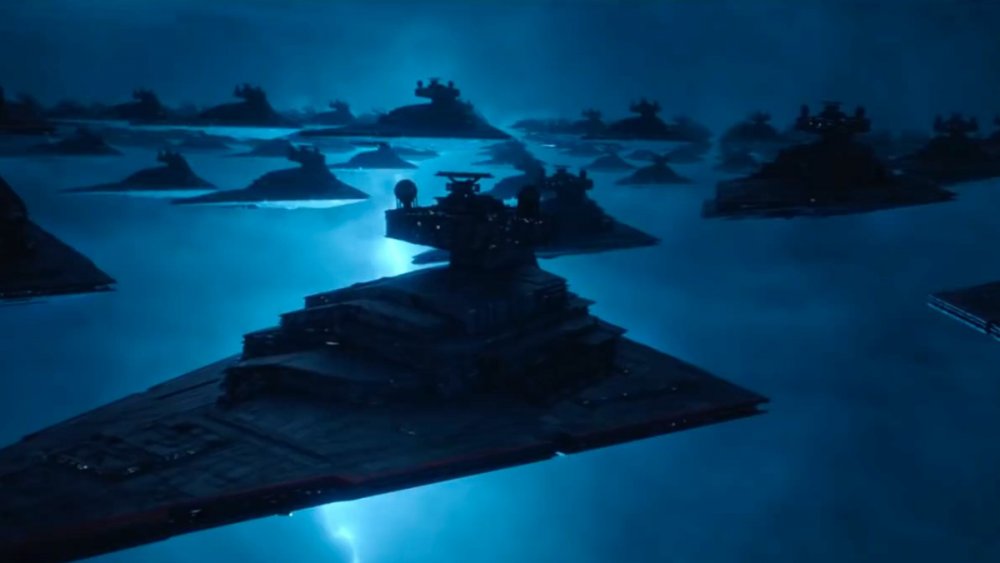Why The Empire Is The Best Part Of Star Wars
When we imagine ourselves in fantasies like Star Wars, it's normal to put ourselves in the roles of heroes. It's fun to think of ourselves as dashing and resourceful as Han Solo or as stalwart and noble as Luke Skywalker. We want to rescue the princess, defeat the forces of evil, and bask in the undying adulation of a galaxy liberated from the grip of terror.
But since the 1977 release of the first Star Wars film, the franchise has grown beyond children's fantasy to forge a compelling mythology. And it's become clearer that, while in the beginning, Star Wars seemed to be little more than a classic battle between good and evil, things are a little bit more complex than they seem. In particular, the First Galactic Empire is more than an irredeemable collection of bad guys. In fact, the Empire and its minions serve the galaxy in more ways than simply as antagonists. And really, when you get down to it, the Empire is pretty much the first, last, and best reason to become engrossed in the mythology that George Lucas built.
Keep reading to find out exactly why the Empire is the best thing about Star Wars.
Without the Empire, there would be no Star Wars
Whether you're talking about Luke Skywalker, Din Djarin, or Ahsoka Tano, you can't have a hero without a villain. Without people like the Sith and the galaxy's many criminal organizations, there would be nothing for the heroes of Star Wars to do. Consequently, without the Empire, there would be no Star Wars. Without the Empire, there would be no rebellion or anything for them to rebel against. The most iconic heroes of the franchise would be spending their time much differently. The Skywalkers, for example, would be living quiet lives, probably in some idyllic corner of Naboo.
While the original film trilogy is when the Empire is the most obviously active, in truth, they're the bad guys of the entire Skywalker Saga. The bad guys of the prequels — chiefly Senator Palpatine — make up what later becomes the First Galactic Empire. While the antagonists of the sequel trilogy are usually called the First Order, they're built from the remnants of the Empire, and as we learn in The Rise of Skywalker, it's still Palpatine who's manipulating things from the shadows.
Even in The Mandalorian, the Empire is still a force to be reckoned with. Villains like the Stormtroopers, the elite Death Troopers, and Moff Gideon play important roles in spite of the Empire supposedly being in ruins.
The Empire has the coolest technology
Each time a new Star Wars film or TV show is announced, one of the first questions fans ask is what new gadgets and vehicles we're going to see. That's because whether you're talking about the humming lightsabers the Jedi and Sith duel with, the lightspeed spaceships racing through the galaxy, or the sometimes menacing and sometimes hilarious droids serving good and bad guys alike, the fantastic tech of the Star Wars universe is one of its most alluring aspects. And of all the fantastic tech we see in the stories, the coolest stuff comes from the Empire.
Chief among the awesome advances of the First Galactic Empire is, of course, the Death Star — the weapon so incredible they made it twice, or three times if you include Starkiller Base, which is really just the Death Star super-sized. The Death Star is so massive that when the heroes first see it in 1977's A New Hope, they mistake it for a moon, until Obi-Wan Kenobi famously corrects them. It destroys planets, or entire systems in the case of Starkiller, with the one minor flaw that it really doesn't take that much to blow it up.
And the cool tech doesn't stop there. There's the Empire's fleet of Star Destroyers, not to mention the screaming TIE Fighters. And arguably the single most intimidating land vehicle in the saga belongs to the Empire — the massive AT-AT walkers that make short work of the defenders of Hoth in The Empire Strikes Back.
Emperor Palpatine is one of Star Wars' best villains
When you consider the fact that we don't meet Emperor Palpatine in the flesh until Return of the Jedi – the final installment of the original trilogy — it's amazing what a powerful impression the sinister Sith had on the original generation of Star Wars fans. He was successful enough of a villain that he was eventually revealed to be the chief antagonist of the entire Skywalker Saga.
If you watch the movies in order of release, Palpatine's arrival on the new Death Star in Return of the Jedi is the first time you can put a clear face to the malevolent Dark Side of the Force that Obi-Wan Kenobi and Yoda warn Luke about in the earlier movies. Yes, Darth Vader is in every film of the original trilogy, but his face and all his expressions are hidden behind a cold, black mask. When we first meet the Emperor, it's like meeting the devil himself.
One of the most brilliant things about Palpatine's conception is that, in many ways, he's a twisted reflection of Yoda. In particular, he's a perfect example of Yoda's famous quote, "Judge me by my size, do you?" While he appears to be physically frail, it's clear he's more powerful than Luke or Vader, eventually falling victim to his apprentice only because he gets distracted torturing Luke. Plus, his appearance is the first time we see any Star Wars character use Force lightning — an ability that makes him seem like a vengeful god.
The Empire ended the Republic's ineffectual bureaucracy
It would be naive to think Palpatine installed himself as the head of the First Galactic Empire for the good of the galaxy. The Sith Lord spends decades manipulating events so he can ascend from his position of senator of Naboo to the tyrannical leader of the Empire, and he does it to sate his own hunger for power. Still, putting aside the Emperor's motivations, in some ways, the Empire improves things in the former Republic, most notably in cutting through the bureaucracy of the Galactic Senate.
The Trade Federation's invasion of Naboo in The Phantom Menace is a perfect example. In spite of Padme risking life and limb to get to Coruscant, her desperate plea for assistance from the Galactic Senate exposes the political body's inaction. Hoping for swift justice, Padme is instead asked to wait as her homeland is occupied by a hostile force so a commission may be formed to "explore the validity" of her accusations.
As we eventually learn, Palpatine is the puppet master who set all these events in motion. But the fact that it's even possible for Padme to be faced with such bureaucratic nonsense as her people are under siege is proof the Republic was desperate for change. For better or worse, the Empire brought that change. Rest assured, if one planet in the Empire attacked another without Imperial sanction, the Emperor's armies wouldn't wait for a few dozen committee meetings before taking action.
The Empire wants order and peace for the galaxy
During its rule, the Empire does its best to bring peace to the galaxy. The peace it wants is probably not ideal, and it's a peace found at the end of a gun, but ultimately, the Empire does want peace. It wants to rule over the galaxy without any contenders challenging their reign. From the Empire's point of view, the wars of Star Wars don't spring from the Empire but from the "Rebel scum." And one example of how the Empire brings peace is how it protects its citizens from criminal organizations that would prey on them.
We see this in season 2 of The Mandalorian. In "Chapter 9," Cobb Vanth tells Mando that right after the news of the second Death Star's destruction reached Mos Pelgo, the Mining Collective took advantage of the situation and invaded the town, enslaving any survivors. It's more than likely that was just one of many such massacres that went down after the Empire fell. In fact, earlier in the same episode, the mechanic Peli tells Mando that since the fall of the Empire, she's been too afraid to wander outside the boundaries of the Mos Eisley spaceport.
Which isn't to say the Empire existed purely to help people, but the fact remains they protected civilians from criminal elements. In The Phantom Menace, Qui-Gon tells his allies, "There's always a bigger fish." And while the Empire ruled galaxy, they were the bigger fish.
The Empire provides a united front against outside threats
The universe is a big place. Even in Star Wars, there's plenty of uncharted space, along with plenty of charted space that's too wild for anyone to claim they know who or what's there at any given time. And while it's usually the Sith, the Hutts, and other known threats we're presented with, there are other, scarier villains out there that the Empire acts as a buffer against.
In fact, while it's no longer considered a canonical part of Star Wars, in the so-called "Legends" continuity, Emperor Palpatine knows about one of the bigger threats waiting to attack the Republic, and it's actually one of his less selfish reasons for creating the First Galactic Empire. In the New Jedi Order book series, the deadly Yuuzhan Vong invade the New Republic from outside the galaxy and kill hundreds of trillions — including Chewbacca — and it turns out Palpatine knew about the Yuuzhan Vong and was preparing for their attack before he died.
We'll never know how many of the dead may have been saved if Palpatine and the Empire had been there to stand against the Yuuzhan Vong, particularly considering the Sith Lord knew more about them than the leaders of the New Republic.
Without the Empire, there would be no K-2SO
Some of the most lovable and memorable characters in the Star Wars saga are droids. And few droids are more fun, have more personality, or are as good in a fight as K-2SO of Rogue One: A Star Wars Story. If you agree, then you better remember at least a little bit of your thanks is owed to the Empire.
Acting as mission partner to Cassian Andor when we first meet him, K-2SO has a few things in common with C-3PO. Like the protocol droid, K-2SO is the main source of comic relief for the band of heroes, and he has a hard time taking so much as a single order from Cassian or anyone else without arguing against it. Thankfully — because, otherwise, he would just be a carbon copy — K-2 is a lot less whiny than C-3PO, preferring cutting sarcasm and passive-aggressive comments to the melodramatic protests of the gold-plated protocol droid. Strong and programmed in combat, K-2 is also a great ally in a firefight, ultimately sacrificing himself for his human allies toward the end of Rogue One.
All this is made possible by the Empire. While he serves the Rebel Alliance, K-2SO is initially a KX-series security droid captured and reprogrammed by the Rebels. Sure, since he's been reprogrammed, his fun, sardonic personality is likely mostly due to his Rebel programmers, but without the Empire, he wouldn't exist in the first place.
One person's Empire is another person's Federation
One of the ways you could describe the Empire is as a vast collection of planets united under a central government. We have another example of something like this in a fictional franchise set in space, and we see them through a much more heroic lens — the United Federation of Planets of Star Trek. The Empire and the Federation are different in a lot of ways. Unlike the Empire, the Federation doesn't like conquest. The Federation doesn't threaten planets with destruction, and it focuses more on science, exploration, and diplomacy than military power.
But let's remember two things. First, we never get a chance to see exactly what the Empire wants for its people. It's possible Palpatine would want to pursue similar goals to the those of the Federation, if for no other reason than to increase his power. But almost as soon as the Empire is established, the Rebellion rises against it, forcing Palpatine to focus on war. Second, the Federation is not as different from the Empire as it would like to admit. It may not destroy planets, but in Star Trek: Picard, we learn that it does condemn billions of Romulans to death when their sun goes supernova, largely because it doesn't want to alienate its allies. And it's dealt with its own rebellions, such as the Maquis who opposed the Federation's treaty with the Cardassians, and as a result, it clashed with both powers.
The Empire forced the Jedi to face their flaws
Before the declaration of the infamous Order 66, the Jedi Council was one of the most influential organizations in the Old Republic. As we saw in The Clone Wars, even relatively young Jedi like Anakin Skywalker held high ranks in the Republic's military. And even before the Clone Wars, Jedi like Yoda and Mace Windu commanded a great deal of respect and influence among the leaders of the Republic. But while it may seem crass, considering the events of the prequels, Order 66 served as a powerful wake up call for the Jedi.
The very fact that it took until Revenge of the Sith for the Jedi to figure out what Palpatine was doing was proof enough that, before their fall, the Jedi Council suffered from arrogance and carelessness. When faced with the possibility that Count Dooku was working with the Separatists, most members of the Council dismissed the possibility, even though they soon learned of the former Jedi's treachery. They kept their diminishing connection to the Force a secret, and in spite of knowing of the existence of a Sith Lord conspiring against them for decades, they only confirmed it was Palpatine because he flat-out told Anakin who he was.
Obviously, neither Palpatine nor his servants commenced the culling of the Jedi because it was "for their own good." Regardless, when you look at the facts, it's clear they needed something to wake them up.
Of course ... Darth Vader
The Emperor's cackle may be a chilling and familiar sound. Darth Maul's red skin and threatening horns may make him look cooler than just about any Sith we know. Count Dooku may have benefited by being played by Christopher Lee, the same actor who gave us the treacherous Saruman of The Lord of the Rings. But no Star Wars villain of any film, any TV series, or any media at all is as iconic as Darth Vader. And Darth Vader, obviously, would have no home in Star Wars if it weren't for the Empire.
With a pitch-black mask reminiscent of a skinless skull, his ceaseless mechanical breathing, and the rich voice of James Earl Jones, Darth Vader is one of the most imposing figures in Star Wars. Everything about the villain is unique. When you hear his voice or his breath, or when you see his silhouette, he's instantly recognizable. And while he's the embodiment of pure evil for much of the original trilogy, by the third film, we learn he's a much more layered and tragic character than we could've expected.
Whether you're a fan of the sequel trilogy or not, you have to admit that Vader is so iconic that even though the Sith is long dead by The Force Awakens, his presence can still be felt. It's why Kylo Ren keeps Vader's melted helmet and speaks to it, as if it were a totem to some dark god.
The Empire keeps the story of Star Wars going
The Death Stars may have all been destroyed long ago, and the New Republic may rise to power, but it's clear the Empire is never dead for good. As a result, Jedi and bounty hunters may come and go, but it's the Empire that fuels the continuing saga of Star Wars.
Set before the events of A New Hope, the animated series Star Wars Rebels features the Empire as its primary antagonists. The Mandalorian – set a few years after the destruction of the second Death Star – features plenty of Stormtroopers, TIE Fighters, and high-ranking Imperial officers. And in The Rise of Skywalker, we learn the Emperor has been the main villain all along. The Empire and its minions are the antagonists of Rogue One, and even though it's set years before Han Solo even considers getting mixed up in any rebellions, the Empire shows up to give him a headache — and, briefly, a job — in Solo: A Star Wars Story.
With the Skywalker Saga completed, the future architects of the franchise may choose to move further away from the defeated Empire. But it seems doubtful — considering how important they are to the galaxy's history — that they will ever completely fade away. Every Star Wars story for a good, long while is likely to include the Empire in some shape or form.
